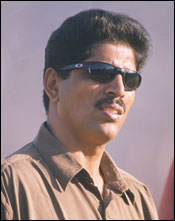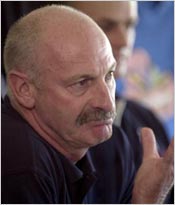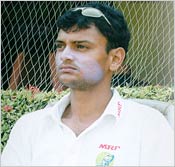The Rediff Cricket Interview/ T A Sekhar
'Is there any doubt about the
abilities of the players
from Tamil Nadu?
How is the health of pace bowling in the country?"
"Very good and encouraging. I think our strength is fast bowling now," he replied.
Coming from the man who knows more about pace bowling in the country than anyone else, you are tempted to believe the assessment.
 Tirumalai Ananthan Sekhar played just two Tests for India in the eighties, after replacing S Madan Lal, his colleague on the present Board of Control for Cricket in India selection committee. He didn't score a run, and didn't get a single wicket. The strong righthand medium pacer also played three one-dayers against England, but never wore the whites again for his country, at a time when pace bowlers were considered alien to the nation.
Tirumalai Ananthan Sekhar played just two Tests for India in the eighties, after replacing S Madan Lal, his colleague on the present Board of Control for Cricket in India selection committee. He didn't score a run, and didn't get a single wicket. The strong righthand medium pacer also played three one-dayers against England, but never wore the whites again for his country, at a time when pace bowlers were considered alien to the nation.
Today, besides being a national selector, the 44-year-old Sekhar is chief coach at the MRF Pace Academy. In a freewheeling interview with Cricket Correspondent Faisal Shariff, he assesses India's fast bowling strengths.
What has brought about a change in trend in India's pace bowling department?
The change in trend has been triggered off by the coaching system that the MRF Pace Academy has set up. Before the academy, fast bowling was unknown in India, leave aside Kapil Dev, who was only a swing bowler.
Dennis Lillee changed the trend with the academy, and everyone wanted to emulate Kapil Dev. That, to my mind, are the two factors that brought about the change in trend.
There was no fast bowler in the country before Kapil. If only Kapil had someone to bowl along with him, he would have been such a different bowler, who would have achieved much more. Fast bowlers always hunt in pairs. After Kapil went out, there was no one left except Javagal Srinath and Venkatesh Prasad, but they were not given the kind of wickets that are conducive for fast bowling.
Are you happy with the domestic scenario?
 No, I am not completely satisfied with domestic cricket in India. Our vision has to be to produce better cricketers. We must sit and think where we are going wrong; brainstorm with the former greats of the game, then crystallise those thoughts. We must go for lively wickets, allow one bouncer in the one-day game as well; a wide should be only above the head.
No, I am not completely satisfied with domestic cricket in India. Our vision has to be to produce better cricketers. We must sit and think where we are going wrong; brainstorm with the former greats of the game, then crystallise those thoughts. We must go for lively wickets, allow one bouncer in the one-day game as well; a wide should be only above the head.
If a bowler didn't bowl a bouncer, can't pitch wide, and can't have more than two men outside the circle, what's the point of the game?
Michael Bevan is a one-day great, but is no good in Tests. We don't need that scenario in our country. We need a broader perspective to our domestic structure.
Take, for example, the Duleep Trophy: its league system is pathetic. You are giving every team more chance for mediocrity instead of motivating them further to win each outing. Bombay won the Ranji Trophy for some 30 years on the trot; Karnataka won it for some six years on the trot. What's the point? It doesn't mean that these teams are strong; it just means that the opponents are weak; the structure is weak.
Look at the Ranji system. How do you select players from the Super League when every team gets through. The Ranji Trophy should go back to the old system. Only two teams should qualify; and then have a knock-out.
I would rather have a better tournament than the Challenger Series. There should be four teams -- India Seniors, India-A, India-B and the Under-19. So, there we have the best 56 cricketers in the country together. The national selectors will pick the teams; all the top players should be available. Play four matches and whoever can get Sachin [Tendulkar], Sourav [Ganguly], [Rahul] Dravid and [VVS] Laxman out should be looked at closely.
And why play one-day alone? Have a one-day tournament and a four-day tournament as well. All the four-day games should be played at one Test centre on a green top and a turning track; both should be good wickets. Try the cricketers out on both wickets; see how he copes with the wickets and make your call. It could be a forerunner to the season. It will generate a lot of interest with spectator participation. The winner of the tournament should then play the Rest of India. That, according to me, is the way to go about our domestic cricket.
What are the academy's future plans?
We are planning to go in for computer software, which will help us analyse technique scientifically. It will help the bowlers to understand better the mistakes they make and rectify them. It is Australian software, called 'Video Expert', which works on angles. Suppose you are a bowler with an action similar as [Javagal] Srinath, then the software can superimpose your image on his and compare the two frames. Even if you are a left-armer, we can mirror the image and superimpose it. It is a revolutionary software, which will immensely accelerate the development of budding bowlers.
The software costs about a lakh of rupees and the training to operate the software costs another lakh.
What is your contribution with respect to the quality of knowledge imparted to young, budding pacers at the academy?
Besides the awareness that MRF has created, we have managed to build a system over 14 years of the highest order. Earlier, no coach in India could teach fast bowling. I am not boasting that I produced Srinath, but all that I learned from Lillee helped enormously in my role as trainer.
The main thing about coaching fast bowlers is understanding the dos and the don'ts of the art. I watch a lot of under-16 and under-19 cricket, searching for good skill, good physique, willingness to work hard, mental skill and cricketing acumen. MRF is the university of fast bowling, in my opinion.
What have you learnt from Lillee as a coach?
 Lillee is the best bowling coach in the world. They say great players are not great coach material. Lillee trashes that myth. Sir Don Bradman said he was the best bowler. Lillee also has the best strike rate in world cricket.
Lillee is the best bowling coach in the world. They say great players are not great coach material. Lillee trashes that myth. Sir Don Bradman said he was the best bowler. Lillee also has the best strike rate in world cricket.
When he agreed to join MRF as coach he expressed his desire that a current first class coach should be full-time coach. The reason why Lillee and I gel together is that I know what Lillee wants the boys to do.
We have had all the Sri Lankan bowlers come to our academy; Lance Klusener, Brett Lee and Glen McGrath are some others who came here to train. Zimbabwe's Henry Olonga came here to correct his action. A few of the English boys came here. We have a tie-up with the Australian Cricket Academy. I go to Australia every year -- to Canberra -- to check on the latest developments. Right now we are doing research on the Indian, Sri Lankan and Australian bowlers.
We are trying to study why Indians are weaker than other bowlers in comparison. We are extracting data on body composition, learning ability, fitness and focusing capacity.
Lillee had helped correct Agarkar's faulty foot placement while batting. Venkatesh Prasad and [Debasish] Mohanty still come to Lillee for help. I have learnt most of my coaching skills from Lillee.
How much does it help as selector, given the fact that you are a pace bowling coach as well?
A fast bowler is born, not made. He has to have the intrinsic ability to bowl fast. A spinner takes time and one can work towards being a successful spinner. The masters of spin are in India. The setting up of the NCA is a step in the right direction. I think that to be a selector you have to have a different make-up compared to a coach. A selector is always in the critical light.
It is easy to find fault with someone, but a good coach is someone who can identify the mistakes in a cricketer and rectify them. Aussie coach John Buchanan and Kiwi coach David Trist never played Test cricket, yet they are brilliant at their jobs.
The job of a coach is to have acute man-management sense. To be able to make the players perform to their potential. So, the two jobs are pretty different from each other.
How do you rate John Wright as India's coach?
He has a completely unique line of thought. We tried with Indian coaches but it didn't pay off. He is immensely gifted with wisdom and knowledge, which he will spread to the others. He needs some time to change the Indian mindset.
How difficult really is the job of being a selector?
It is a very tough job. You have to be prepared for the brickbats that come with it. You have to be prepared for criticism as well.
Would you agree that zonal politics exist in the selection process? While the South Zone selector was from Bangalore we had players coming in from Karnataka; then you came, and players from TN started finding their way into the team. How do you explain this?
There are five zones and there is one selector from each zone, but I can assure you that no zonal politics exist. Take Dinesh Mongia, who is from Punjab. Can anyone suppress his progress? There is no selector from Punjab, still we are looking at him very closely.
It is a very tough job being a selector in a country as big as ours. It is very difficult to judge good, first class cricketers on the placid wickets here. If you are a decent batter you can get 1,000 runs in nine matches in the domestic level. Then you play Duleep and Deodhar and get another 400 runs and you are in the reckoning. There should be a clear demarcation to really judge the abilities of quality players.
It is just how it suits people. And, anyway, tell me one place where there is no politics? There was politics in Australian cricket too. Mark Taylor was given an extended career, which hampered Slater's career. Politics is a relative term. They said Vivian Richards only liked people from his island. Imran Khan also did it in Pakistan. We are all human, after all.
Is it true you are given a percentage of the match-fee if a player is selected from a particular club in Tamil Nadu?
 I have heard about this too. It is just petty jealousy. Is there any doubt about the abilities of the players from Tamil Nadu? Can you question [Hemang] Badani's talent? All Tamil Nadu boys are immensely talented and have earned their places in the side. [Sridharan] Sriram was in the side because he can bat and bowl besides being an excellent fielder. When [Thiru] Kumaran made it to the team he claimed 48 wickets in one season, with 11 in a single game.
I have heard about this too. It is just petty jealousy. Is there any doubt about the abilities of the players from Tamil Nadu? Can you question [Hemang] Badani's talent? All Tamil Nadu boys are immensely talented and have earned their places in the side. [Sridharan] Sriram was in the side because he can bat and bowl besides being an excellent fielder. When [Thiru] Kumaran made it to the team he claimed 48 wickets in one season, with 11 in a single game.
I look at them as players. If they are good, I give them a chance. If they use that chance, good enough; if they don't, too bad! Opportunity comes for everybody.
Where is Kumaran today? Why is he not in the reckoning anymore?
Kumaran had his chance and he let it slip. After the Australian tour, his performance dipped sharply. He has slipped badly. You can only accommodate 14 players in a team, right? We thought he wasn't quite cut out for the highest level. But he has been trying hard to prove us wrong.
You can also read:
'Srinath and Prasad came on their own'
Interviews
Mail Cricket Editor